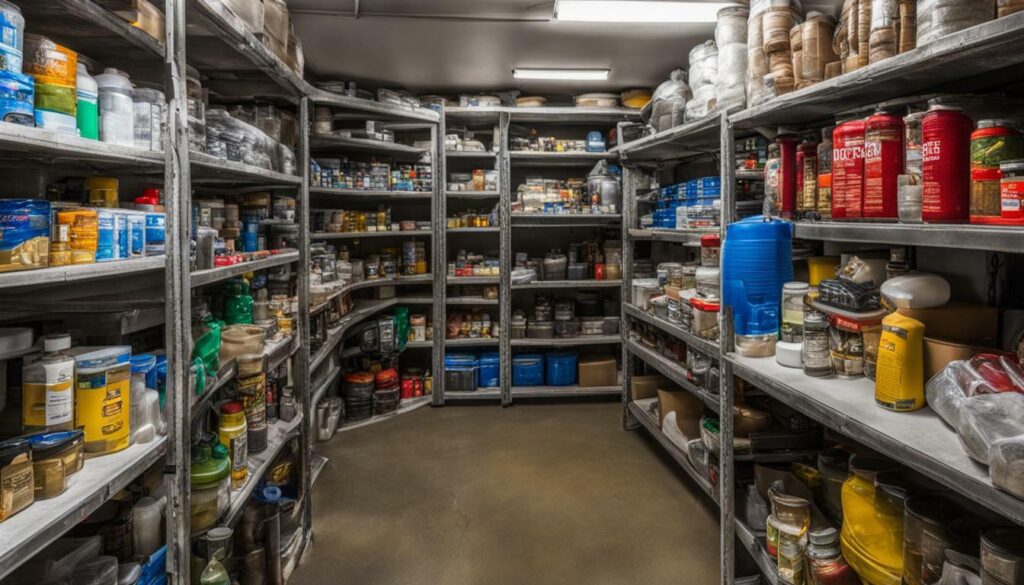In this article, I will share tips and techniques on how to get power without electricity. Whether you are looking for alternative power sources, off-grid power solutions, or renewable energy options, you will find valuable information to help you achieve energy independence and live sustainably.
Exploring Alternative Power Sources
When it comes to generating power without relying on electricity, there are a plethora of alternative power sources available. Exploring these options can provide sustainable and self-sufficient power solutions for those seeking off-the-grid living.
One of the most popular alternative power sources is solar power. By harnessing the energy from the sun, solar panels equipped with photovoltaic cells can convert sunlight into usable electricity. Solar power systems can be utilized to power homes, businesses, and even remote locations.
Another viable option is wind energy. By installing wind turbines in areas with consistent wind patterns, such as coastal regions or open landscapes, one can capture the kinetic energy of the wind and convert it into electrical energy. Wind power is a clean and abundant source of energy, making it an attractive choice for reducing reliance on traditional power sources.
1. Hydroelectric Power
Hydroelectric power is a reliable and renewable source of energy that utilizes the kinetic energy of flowing water to generate electricity. By installing water turbines in rivers or streams, individuals can harness the power of water to produce electricity without the need for traditional electrical infrastructure. This makes hydroelectric power a suitable option for off-grid living and remote locations with access to water bodies.
Furthermore, biomass energy offers a sustainable and eco-friendly power alternative. By converting organic materials such as agricultural waste, wood pellets, or biofuels into usable energy, biomass energy can be utilized for heating, cooking, or generating electricity. This renewable energy source allows individuals to reduce their carbon footprint and live off the grid.
By exploring these alternative power sources, individuals can embrace non-electric power generation and achieve energy independence. Alongside these alternative options, enhancing energy efficiency through practices such as using energy-efficient appliances and insulating homes can further reduce power consumption. The combination of alternative power sources and energy-efficient practices can lead to a more sustainable future for off-the-grid living.
Hydroelectric power presents a promising solution for those seeking off-grid power solutions and sustainable energy alternatives. By harnessing the power of flowing water, hydroelectric systems can generate electricity without relying on traditional electrical infrastructure. Water turbines, designed to capture the kinetic energy of rivers or streams, convert it into electrical energy.
One of the key advantages of hydroelectric power is its renewable nature. As long as there is a constant flow of water, the energy generated can be sustained indefinitely. This makes it an attractive option for off-grid living and remote locations where access to traditional power sources may be limited.
In addition, hydroelectric power systems produce clean energy with minimal environmental impact. Unlike fossil fuels, hydroelectric power does not emit greenhouse gases or contribute to air pollution. This makes it an environmentally-friendly choice for those passionate about reducing their carbon footprint and promoting sustainable living.
Advantages of Hydroelectric Power:
- Renewable and sustainable energy source
- Minimal environmental impact
- Reliable power generation with consistent water flow
- Potential for off-grid living and remote power solutions


By embracing hydroelectric power, individuals can take a significant step towards energy independence and reduce their reliance on electricity. Whether it’s installing water turbines in local water bodies or seeking out hydroelectric power projects in the vicinity, there are various ways to tap into this abundant and renewable energy source. With the right setup and proper maintenance, hydroelectric power can provide a consistent and sustainable energy solution for off-grid living.
2. Harnessing Solar Energy for Power
Solar power is a popular and accessible alternative power source that harnesses the energy from the sun to generate electricity. By installing solar panels equipped with photovoltaic cells, you can convert sunlight into usable electricity. Solar power systems can be used to power homes, businesses, and even remote locations. With advancements in technology, solar power has become more efficient and affordable, making it a viable option for those seeking power without electricity.
Solar panels are made up of photovoltaic cells that absorb sunlight and convert it into electricity. The cells consist of semiconductor materials, usually silicon, that create an electric current when exposed to sunlight. This direct current (DC) is then converted into alternating current (AC) by an inverter, making it compatible with the electrical systems in our homes and businesses.
One of the key advantages of solar power is its ability to provide clean and renewable energy. Unlike fossil fuels, solar power does not produce harmful emissions or contribute to air pollution. It is a sustainable energy source that can help reduce our carbon footprint and combat climate change. Additionally, solar power systems require minimal maintenance and have a long lifespan, making them a cost-effective solution in the long run.
Advancements in Solar Technology
In recent years, there have been significant advancements in solar technology that have made solar power more efficient and affordable. The efficiency of solar panels has improved, allowing them to generate more electricity from the same amount of sunlight. This means that even in areas with less sunlight, solar power can still be a viable option.
Furthermore, the cost of solar panels has been steadily decreasing, making them more accessible to a wider range of consumers. Government incentives and tax credits are also available in many areas, further reducing the cost of installation. As a result, more and more individuals and businesses are embracing solar power as a sustainable and cost-effective energy solution.
3. Tapping into Wind Energy for Power Generation
Wind energy is a renewable energy source that harnesses the power of the wind to generate electricity. By utilizing wind turbines, we can capture the kinetic energy of the wind and convert it into usable electrical energy. Wind power is a clean and abundant resource, making it an attractive option for those looking to reduce their reliance on traditional power sources.
Wind turbines, also known as windmills, consist of large blades connected to a rotor. As the wind blows, it causes the rotor to spin, which in turn rotates a generator to produce electricity. These turbines can be installed in areas with consistent wind patterns, such as coastal regions or open landscapes, where they can efficiently capture the energy of the wind.
One of the advantages of wind energy is its scalability. Wind farms can range from small-scale installations for individual homes to large-scale projects that generate electricity for entire communities. Additionally, the advancements in technology have led to more efficient and quieter wind turbines, making them a viable option for residential areas as well.
Harnessing the Power of Wind Turbines for Sustainable Energy
Wind energy, through the use of wind turbines, offers a sustainable and eco-friendly solution for power generation. By tapping into the power of the wind, we can reduce our carbon footprint and contribute to a cleaner environment. Wind power, alongside other renewable energy sources, plays a crucial role in shaping the future of sustainable energy and moving towards a greener planet.
4. Embracing Biomass Energy for Sustainable Power Generation
When it comes to sustainable power alternatives, biomass energy offers a promising solution. By converting organic materials such as agricultural waste, wood pellets, or biofuels into usable energy, we can reduce our reliance on traditional power sources and make a positive impact on the environment.
Biomass energy provides a renewable and eco-friendly power option that can be used for various purposes. Whether it’s for heating, cooking, or generating electricity, biomass energy offers a versatile solution that can be applied in both residential and industrial settings. By embracing biomass energy, we can contribute to a greener future while still meeting our energy needs.
Exploring Biofuels as a Sustainable Power Source
One of the key components of biomass energy is biofuels. Derived from organic materials such as corn, sugarcane, or algae, biofuels can be used as an alternative to fossil fuels in transportation and power generation. With advancements in technology, biofuel production has become more efficient and cost-effective, making it a viable and sustainable power source.
By using biofuels, we can significantly reduce carbon emissions and decrease our dependence on non-renewable resources. Biofuels can be used in vehicles, heating systems, and even power plants, providing a cleaner and more sustainable alternative to traditional fuels. Embracing biofuels as a part of our energy mix can help us achieve a more sustainable and greener future.
Advantages of Biomass Energy
There are several advantages to embracing biomass energy as a sustainable power generation option. Firstly, biomass energy is a renewable source, as organic materials can be replenished through farming and forestry practices. This ensures a continuous and sustainable supply of fuel for power generation.
Secondly, biomass energy reduces greenhouse gas emissions compared to fossil fuels. Organic materials used in biomass energy production release carbon dioxide during combustion, but this is offset by the absorption of carbon dioxide by the plants during their growth cycle. This creates a carbon-neutral cycle, making biomass energy a more environmentally friendly choice.
Lastly, biomass energy helps in waste management by utilizing organic waste materials that would otherwise be disposed of in landfills or burned. By converting these waste materials into energy, we can avoid the release of harmful pollutants into the environment and reduce the strain on waste management systems.
Enhancing Energy Efficiency to Reduce Power Consumption
When it comes to achieving power without relying on electricity, enhancing energy efficiency plays a vital role. By implementing simple yet effective measures, you can significantly reduce power consumption and minimize your reliance on traditional electric grids. Not only does this help you save on energy costs, but it also contributes to a more sustainable and eco-friendly lifestyle.
One of the key ways to enhance energy efficiency is by using energy-efficient appliances. Look for appliances with the ENERGY STAR label, as they have been specifically designed to consume less energy without compromising on performance. From refrigerators and washing machines to light bulbs and televisions, opting for energy-efficient options can make a noticeable difference in your overall power consumption.
In addition to using energy-efficient appliances, insulating your home is another effective way to improve energy efficiency. Proper insulation helps to minimize heat transfer, keeping your home cooler in the summer and warmer in the winter. By reducing the need for heating and cooling, you can significantly reduce your power consumption and save on energy bills.
Practicing efficient energy usage
To further enhance energy efficiency, it is essential to practice efficient energy usage in your everyday activities. This includes turning off lights and appliances when not in use, utilizing natural lighting as much as possible, and maximizing the use of daylight. Additionally, consider using power strips with an on/off switch to easily disconnect multiple devices from power when they are not needed.
Enhancing energy efficiency is a crucial aspect of reducing power consumption and achieving power without relying on electricity. By utilizing energy-efficient appliances, insulating your home, and practicing efficient energy usage, you can make a significant contribution to sustainable living and reduce your carbon footprint. Embracing these energy-saving habits allows you to maximize the power generated from alternative sources and live more harmoniously with the environment.
Conclusion
To achieve energy independence and live sustainably, it is essential to explore alternative power sources and embrace off-grid power solutions. By harnessing the power of renewable energy options such as solar, wind, hydroelectric, and biomass, individuals can reduce their reliance on traditional electricity and pave the way for a more sustainable future.
By implementing solar power systems equipped with photovoltaic cells, we can convert sunlight into usable electricity, providing a reliable and accessible alternative power source. Wind energy, on the other hand, can be harnessed through the installation of wind turbines in areas with consistent wind patterns, offering a clean and abundant source of power.
Hydroelectric power, utilizing the kinetic energy of flowing water, and biomass energy, derived from organic materials, provide additional sustainable power alternatives. These methods can be employed in off-grid living and remote locations with access to water bodies, creating self-sufficient power solutions.
Furthermore, enhancing energy efficiency through the use of energy-efficient appliances, insulating homes, and practicing efficient energy usage can significantly reduce power consumption. By adopting energy-saving habits, we can maximize the power generated from alternative sources and achieve our goal of living sustainably without relying on electricity.
FAQ
What are some alternative power sources that can generate power without electricity?
Alternative power sources include solar power, wind energy, hydroelectric power, and biomass energy.
How does solar power generate electricity without relying on traditional electric grids?
Solar power utilizes solar panels equipped with photovoltaic cells to convert sunlight into usable electricity.
How can wind energy be harnessed to generate power without electricity?
Wind turbines capture the kinetic energy of the wind and convert it into electrical energy.
What is hydroelectric power and how does it generate electricity without relying on electricity?
Hydroelectric power harnesses the kinetic energy of flowing water by installing water turbines in rivers or streams.
What is biomass energy and how does it generate power without electricity?
Biomass energy involves converting organic materials like agricultural waste or biofuels into usable energy for heating, cooking, or electricity generation.
How can energy efficiency be enhanced to reduce power consumption?
Energy efficiency can be improved by using energy-efficient appliances, insulating homes, and practicing efficient energy usage.
How can individuals achieve power without relying on electricity?
By harnessing alternative power sources like solar, wind, hydroelectric, and biomass energy, practicing energy efficiency, and embracing off-grid power solutions, individuals can achieve energy independence and reduce their carbon footprint.








